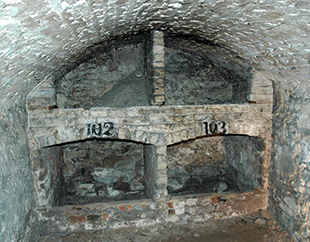












When vaults are built underground, the ground gives all the resistance required. However, when the vault is built above ground, various replacements are employed to supply the needed resistance. An example are the thicker walls used in the case of barrel or continuous vaults. Buttresses are used to supply resistance when intersecting vaults are employed.
The simplest kind of vault is the barrel vault (also called a wagon or tunnel vault) which is generally semicircular in shape. The barrel vault is a continuous arch, the length being greater than its diameter. As in building an arch, a temporary support is needed while rings of voussoirs are constructed and the rings placed in position. Until the topmost voussoir, the keystone, is positioned the vault is not self-supporting. Where timber is easily obtained, this temporary support is provided by centering consisting of a framed truss with a semicircular or segmental head, which supports the voussoirs until the ring of the whole arch is completed. With a barrel vault, the temporary support is then shifted on to support the next rings.
In earlier times, particularly in Chaldaea and Egypt where timber was scarce, other means of support had to be contrived. Apparently only in Roman times was centering regularly employed.
By Appointment
PARIS CERAMICS
South Park Studios - Suite 10
88 Peterborough Road, London SW6 3HH
United Kingdom